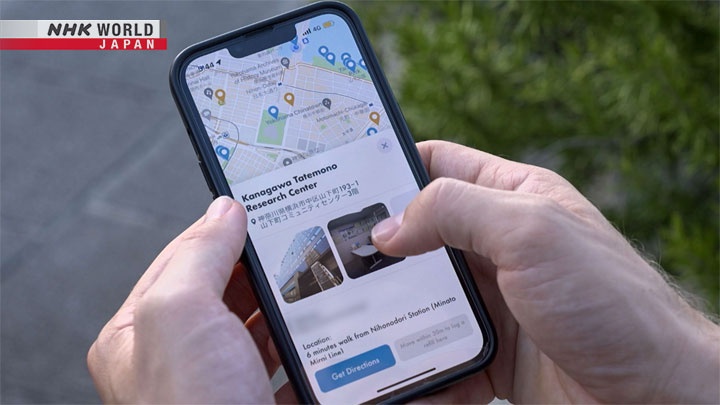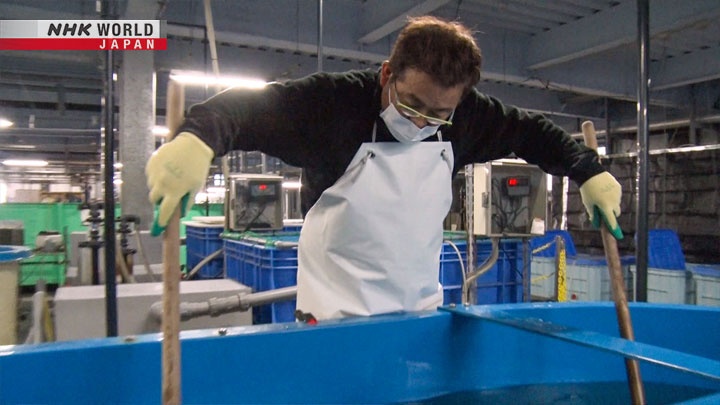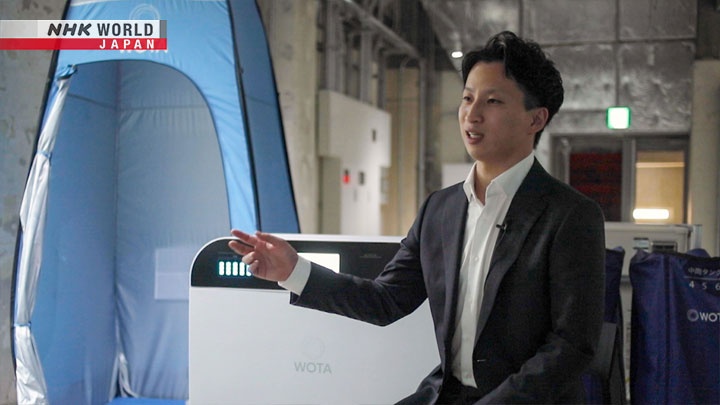Cherishing Water and Abundant Oceans
Water is an essential part of our lives. However, with ocean pollution and global water shortages, there is growing concern about water security. This begs the question, what are some choices and actions we can take now to protect the future of our precious water and oceans? In this episode, we'll present four ideas that address these problems.






Transcript
100 Ideas to Save the World!
Hello, and welcome to the show.
My name's Ben Matsuka Williams.
In this program, we take a look at inspiring stories about how people
are working to achieve the UN's 17 Sustainable Development Goals or SDGs,
based on segments from past NHK WORLD-JAPAN programs.
This time on the show, we're focusing on the importance of water and our precious oceans.
Water is an essential part of our lives.
However, with ocean pollution and global water shortages,
there is growing concern about the future of our water security.
This begs the question, what can we do now to protect our precious water resources?
In this episode, we'll present four ideas that address these problems.
Our first idea is about one man who aims to create a more sustainable world
by having everyone carry around their own water bottles that can be filled up in various locations.
Let's take a closer look at his initiative.
Idea 93.
An app called mymizu, on which users can locate spots to fill up their water bottles.
In addition to public water fountains
in places like parks and train stations,
many restaurants, cafes, and hotels have joined in as so-called "water partners."
It caters to a growing number of people choosing to not buy plastic bottles;
and instead refill their own reusable bottles, for free.
The creator of the app is social entrepreneur
Robin Takashi Lewis.
Inspiration for the app came from
witnessing the massive scale of ocean pollution in Okinawa,
where beaches are inundated with garbage like plastic bottles.
He wondered how he could tackle
environmental issues in a creative way.
The first thing was an awareness
around plastic waste
and the necessity for this kind of platform.
Users can contribute information, photos,
and locations of water filling spots.
Thanks to this, the map now shows over 200,000 refill spots in 40 countries.
In addition to keeping track of the
plastic bottles and CO2 emissions reduced,
users can also see how much
money they've saved.
By quantifying these figures visually,
users can see how their actions are making an impact on society.
The platform is now being utilized
in a variety of ways.
This high school ran a campaign called
the mymizu challenge.
Students split into teams and competed to reduce the most number of plastic bottles.
As a result, more than 4,000 plastic bottles were reduced,
and now about 90% of all students at the school use their own bottles.
And to further spread the initiative, they're planning to bring the campaign to other schools.
We use our own bottles!
The mymizu efforts link to a wide range of other activities,
such as online talk events to introduce sustainable initiatives and beach cleanups.
In his past work with numerous international organizations, Lewis has observed
issues around the world, from disaster prevention to humanitarian aid projects.
He hopes the app becomes a catalyst
for collaboration among organizations,
and empowers more people
to get involved in environmental issues.
We're trying to change the "atarimae,"
or what is normal.
We're trying to change the default.
It's about using technology, creativity,
and fun, positive messaging
to get people on board
and build something positive.
I was impressed with how people are tackling environmental issues in such a fun and creative way.
I personally don't like buying disposable plastic bottles, so I'm definitely going to install the "mymizu" app myself.
Moving on, would you know what to do if water became unavailable due to a disaster?
Let's take a look at an amazing invention that solves this problem.
Idea 94.
This little machine being wheeled around, is a portable water recycling device.
The system is quite simple.
First, wastewater is collected and delivered into the apparatus.
The device is equipped with
six internal filters.
AI assesses the condition of the water
and determines which filters are needed.
It effectively treats over 98% of all wastewater on the spot so the water can be instantly reused.
Maeda Yosuke is the device's developer.
He aims to solve the problem of water shortages,
which are predicted to affect 40% of the world's population by 2030.
If there won't be enough water,
it becomes essential to recycle it.
The device can be used to supply water in developing countries and remote areas where there is no water supply.
It's proving useful in disaster areas all around Japan.
In affected areas, sewage treatment plants are damaged and bathing facilities become unavailable.
Units of the device were distributed to municipalities to support the water infrastructure of the local people.
We need to better design
our relationship with water.
Each household treating and reusing
their own water should be the norm.
That's the world we're building.
It's easy to assume that recycling only applies to plastic and other waste,
but this idea has made me realize it's just as important to recycle water.
Fish is an important source of protein, however,
overfeeding and large-scale aquaculture practices could lead to damage to our marine environments.
The next idea is about one researcher's groundbreaking idea that's attracting a lot of attention.
Idea 95.
A round and plump saltwater fish, grouper.
In fact though, it was raised a far cry
from the sea, here in the mountains.
Yamamoto Toshimasa is a specialist
in onshore fish cultivation.
How is it possible for Yamamoto
to raise saltwater fish in the mountains?
The secret is this powder he developed.
Dissolving the powder in fresh water...
allows marine fish, which would otherwise
not survive in freshwater, to swim healthily.
Of the 60 some substances in
natural seawater,
the powder is specially formulated with just three of which fish really need.
As a result, marine fish are able to not just survive, but thrive.
But that's not all.
The water is cleansed with active organic filters and circulated for repeated use.
Normal aquaculture needs to replace 5% of their water each day,
but that number is just 0.1% here.
With these technologies,
fish can be cultivated without having to procure massive amounts of seawater.
We want to open the door
to aquaculture everywhere.
Whether it's in a desert,
a mountaintop, or anywhere else.
Yamamoto has succeeded in
commercial production
of more than 10 kinds of fish,
including blowfish and eels.
The fish are delivered to Japanese
kitchens and used in a variety of dishes.
This sushi is made with Yamamoto's
grouper.
It's highly praised for its
firm and satisfying texture.
Yamamoto has been a shining light
for Japan's aquaculture industry.
He next turned his focus to revitalizing
disaster-affected areas.
Fukushima prefecture.
Impacts from the March 11th, 2011 disaster are still felt here.
The fishing industry has been dealing with ramifications of the nuclear accident.
Here, at a supermarket's seafood section.
Fukushima-caught fish is a rare sight.
Ever since the nuclear disaster,
customers' health and safety concerns
have made it hard to sell local fish.
Using Yamamoto's technology, a project was launched to farm and sell a Japanese favorite,
sockeye salmon, right here in Fukushima.
Soon after launching the project, an aquaculture facility was installed on the supermarket headquarters' premises.
A delivery of 1,000 sockeye salmon fry arrives by truck, to be transferred to the indoor tanks.
It's hoped that these salmon will be ready for market in about one year.
I'm so happy and thankful
that we've finally made it this far.
If this terrestrial aquaculture
can be used in struggling regions,
then at the end of the day,
that's our ultimate goal.
Next up, our final idea for this episode.
Seaweed is a hallmark of a rich and abundant ocean.
However, all too often, once it washes up on land, it's treated as garbage and thrown away.
One culinary artist noticed this, and came together with the local community to change this.
Idea 96.
Meat with deep "umami,"
and fat that melts almost instantly.
This pork, which has become a specialty of Kamakura,
was developed by taking advantage of something
troublesome from the sea.
Large quantities of seaweed that wash up on the beaches.
Left to rot it produces a foul odor,
and so is treated as trash.
However, seaweed is by nature
highly nutritious and mineral-rich.
Culinary researcher Yano Fukiko
was born and raised in Kamakura.
It was her idea to use the seaweed
as pig feed.
For it to rot or go to waste on the beach,
was such a shame.
I wanted to find a way to make use of it.
Yano has brought in various communities to help turn the seaweed into fodder.
With permission from the fishermen's cooperative, people with disabilities
regularly collect seaweed as part of a social participation work program.
We got a lot today.
This is a good spot.
We'll take it from here. Thanks.
Always a pleasure!
Then at a local elder care facility,
the seaweed is washed of salt, cut to an appropriate size, and hung to dry.
It's nice having some work to do
instead of just sitting in our rooms.
The seaweed is then further finely processed, and ready to feed to the pigs.
Good morning!
The finished feed is taken to the pig farm.
At this farm the seaweed had a real impact on the quality of the meat.
The secret to delicious "umami" in pork
is something called oleic acid.
There was more oleic acid
in the pigs that ate the seaweed.
Another benefit is it imparts fat
with a lower melting point.
So it literally melts in your mouth,
enveloping your taste buds.
Yano hopes to get as many people as possible to eat Kamakura pork.
She sees it as a way to give back for
public funding that benefited the area.
Seeing Kamakura Seaweed Pork
on our dining tables,
reminds us of the ocean and beaches.
I hope they appreciate the collaboration
and hard work that went into raising it.
If the people eating it realize this,
that would make me very happy.
Not only has Yano transformed seaweed that had been going to waste into a local specialty.
She's succeeded in bringing people together for a stronger and more connected community.
From keeping our oceans clean, to recycling water on land,
there are so many ways we can help preserve our precious oceans.
I hope today's episode has inspired you to make changes in the way you use water,
no matter how big or small.
What did you think about these Ideas to Save the World?
We'll look at more interesting approaches in our next episode!
This has been ideas 93 to 96, of 100 Ideas to Save the World! Thanks for watching!
All segments featured are available online at NHK WORLD-JAPAN On Demand.
Join us next time!